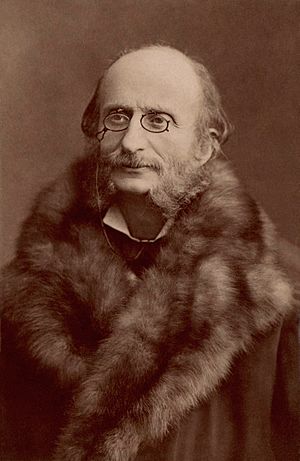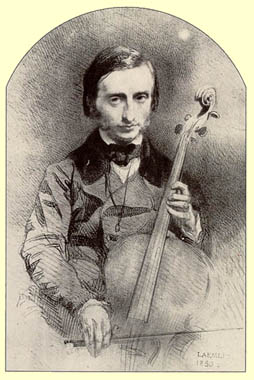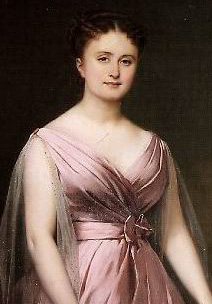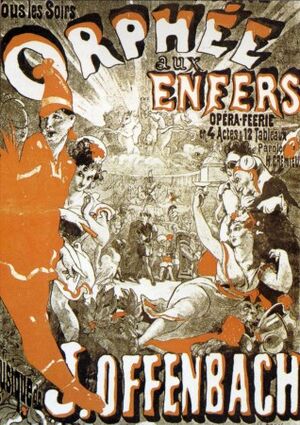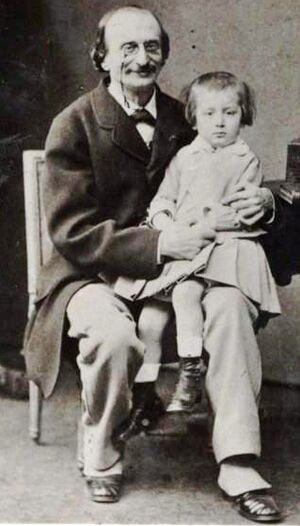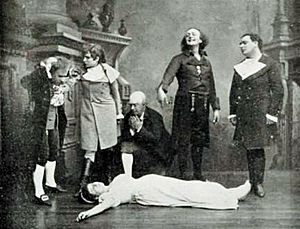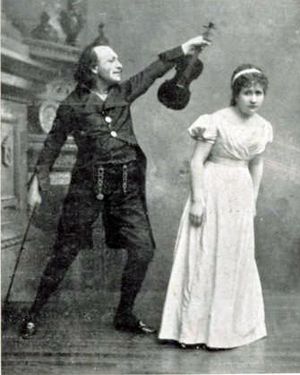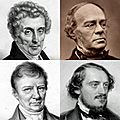Jacques Offenbach facts for kids
Jacques Offenbach (born June 20, 1819 – died October 5, 1880) was a famous composer and cellist. He was born in Germany but became a French citizen. He lived during the Romantic period of music. Offenbach is best known for writing nearly 100 operettas. These are like light, funny operas with singing and spoken parts. He also wrote an opera called The Tales of Hoffmann, which he didn't finish before he died. Many of his works are still performed today. He greatly influenced other composers like Johann Strauss Jr. and Arthur Sullivan.
Offenbach showed musical talent from a young age. He played the cello and composed music. At 14, he went to the Paris Conservatoire, a famous music school. But he found the lessons boring and left after a year. For many years, he worked as a cellist and conductor. He became very good at it and was known internationally. However, his dream was to write funny musical plays for the theater. When the main opera companies in Paris weren't interested in his work, he decided to open his own small theater in 1855. There, he put on his own short, funny shows, and many of them became very popular.
In 1858, Offenbach created his first full-length operetta, Orphée aux enfers ("Orpheus in the Underworld"). It was a huge hit and is still one of his most famous works. Throughout the 1860s, he wrote many more operettas. Some of his well-known works from this time include La belle Hélène (1864), La Vie parisienne (1866), La Grande-Duchesse de Gérolstein (1867), and La Périchole (1868). These shows were funny and often gently made fun of society. Offenbach's beautiful melodies made his music popular all over Europe.
Offenbach was connected to the French emperor Napoleon III. His operettas often made lighthearted fun of the emperor and his court. Napoleon III even made Offenbach a French citizen and gave him a special award. But when the Franco-Prussian War started in 1870, people in Paris were angry at Offenbach because he was born in Germany and was linked to the emperor. He still found success in Vienna and London. Later in the 1870s, he became popular in Paris again. He also went on a successful tour in the United States. In his last years, he worked hard to finish The Tales of Hoffmann. He died before it premiered, but other musicians finished it for him. It is now a standard opera that is performed often.
Contents
Jacques Offenbach's Life and Music
Early Life and Musical Start
Jacques Offenbach was born Jacob Offenbach in Cologne, Germany, in 1819. His family was Jewish, and his father was a cantor (a singer who leads prayers) in a synagogue. His father also taught music.
Jacob showed musical talent very early. When he was six, his father taught him violin. By age nine, he started playing the cello. He was so good that his teacher was amazed by his skills. Jacob, his brother Julius (violin), and sister Isabella (piano) played music together in local cafes.
In 1833, when Jacob was 14, his father decided that Jacob and Julius should study music in Paris. They traveled to Paris and met Luigi Cherubini, the director of the famous Paris Conservatoire. Cherubini was impressed by Jacob's cello playing and accepted him as a student. Jacob changed his name to the French version, Jacques.
Jacques didn't like the strict academic lessons at the Conservatoire and left after only a year. His brother Julius stayed and became a successful musician.
Becoming a Cello Star
After leaving the Conservatoire, Offenbach needed to earn a living. He found work as a cellist in theater orchestras. In 1835, he got a permanent job at the Opéra-Comique. He was known for being a bit of a prankster during performances, but he was also a very talented cellist. He took lessons from a famous cellist, Louis-Pierre Norblin.
The composer Fromental Halévy also taught Offenbach about composing music. Halévy believed Offenbach would become a great composer. Offenbach started writing music for cello and piano, and he performed in fancy parties (salons) in Paris.
To become more famous and earn more money, Offenbach toured France and Germany. He even played with famous musicians like Franz Liszt. In 1844, he toured England and was a huge success. Critics praised his playing, and he even performed for Queen Victoria and other royalty.
Offenbach returned to Paris with a great reputation and more money. He decided to focus more on composing than on playing the cello. He started writing funny musical shows called "burlesques" for the salons. In 1848, a revolution broke out in Paris, so Offenbach and his family moved back to Cologne for safety.
He returned to Paris in 1849 and became the music director for the Comédie-Française theater. He wrote songs and music for plays, which helped him learn how to write for the stage. However, the Opéra-Comique still wasn't interested in his work.
Opening His Own Theater
Between 1853 and 1855, Offenbach wrote three short operettas that were performed and well-liked. Still, the Opéra-Comique didn't want him. He found encouragement from another composer, Hervé, who was creating light comic operas. Offenbach decided to open his own theater.
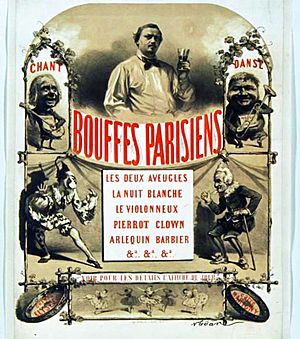
In 1855, Offenbach rented a small theater called the Salle Lacaze in the Champs-Élysées. This was a perfect spot because the 1855 Great Exhibition was happening nearby, bringing many visitors to Paris. His theater was called the Bouffes-Parisiens. It was small, holding only 300 people, and he was only allowed to have three singers on stage at a time. This meant he had to create short, one-act shows.
The opening night was a rush, but it was a success. One of the most popular shows was Les deux aveugles ("The Two Blind Men"), a comedy about two beggars pretending to be blind. It was a hit in Paris and later in other cities like Vienna and London. Another success was Le violoneux, which made a star out of Hortense Schneider, who became one of Offenbach's most important singers.
As winter approached, Offenbach moved his company to a theater in central Paris, the Salle Choiseul. He continued to perform at both locations for a few years until new rules made him choose just one.
Success at Salle Choiseul
Offenbach's first show at the Salle Choiseul was Ba-ta-clan (1855), a funny play with an Asian theme. Over the next three years, he wrote 15 more one-act operettas. The rules allowed him to have four singers now.
Offenbach also let other composers perform their works at his theater. He loved Mozart and even put on Mozart's comic opera Der Schauspieldirektor (called L'impresario in French) in 1856. This helped the Bouffes-Parisiens gain more respect. The emperor, Napoleon III, even asked the company to perform for him.
Offenbach held a competition for new composers. Two winners were chosen: Georges Bizet (who became a good friend) and Charles Lecocq (who became a rival).
Even though the Bouffes-Parisiens was popular, Offenbach spent a lot of money on his productions. To help with finances, he took his company to London in 1857. The trip was successful, but his later works would cause an even bigger stir there.
Orpheus in the Underworld
In 1858, the government changed the rules, allowing Offenbach to use more performers. This meant he could create bigger shows. His first full-length operetta, Orphée aux enfers ("Orpheus in the Underworld"), opened in October 1858. Offenbach spent a lot on the show, with beautiful sets and costumes.
At first, the show was only a moderate success. But then, a critic named Jules Janin wrote an angry review, saying the show was disrespectful to Roman mythology (and secretly, to the government). Offenbach and his writer, Hector Crémieux, used this negative review as free advertising. They argued with Janin in the newspapers, which made everyone curious to see the show. People flocked to the theater, and it became a huge hit. Even the emperor wanted to see it.
Orphée aux enfers remained Offenbach's most popular work. It was loved for its lively waltzes, funny songs, and especially for introducing the famous can-can dance to polite society.
In 1859, Offenbach continued to present new works. One of his new pieces, Geneviève de Brabant, became very popular after he revised it. A duet from it later became the basis for the Marines' Hymn in the U.S.
The Successful 1860s
The 1860s were Offenbach's most successful years. In 1860, Napoleon III made him a French citizen. The next year, he received a special award called the Légion d’Honneur. This upset some serious musicians who thought a composer of light opera shouldn't get such an honor.
In 1860, Offenbach wrote his only ballet, Le papillon ("The Butterfly"). It had a good run of 42 performances. He also had a show, Barkouf, performed at the Opéra-Comique, but it wasn't a success. The story was about a dog, and the music tried to imitate dog sounds, which didn't impress the audience.
Despite that setback, Offenbach had many more successes than failures in the 1860s. He took his company to Vienna in 1861, where they were very popular. He even played the cello again for Emperor Franz Joseph.
In 1862, Offenbach's only son, Auguste, was born. That same year, Offenbach stepped down as director of the Bouffes-Parisiens but continued to write most of his works for the company. In 1864, he wrote a serious opera called Die Rheinnixen, but it wasn't performed much until the 21st century. One part of it, the "Elfenchor," was later used as the famous Barcarolle in The Tales of Hoffmann.
Later 1860s Highlights
Between 1864 and 1868, Offenbach wrote four of his most famous operettas: La belle Hélène (1864), La Vie parisienne (1866), La Grande-Duchesse de Gérolstein (1867), and La Périchole (1868). He worked with writers Henri Meilhac and Ludovic Halévy on these.
For La belle Hélène, Offenbach insisted on having Hortense Schneider play the main role. She was a big star but also known for being difficult. The show's success was helped again by the critic Jules Janin, whose angry review made people even more curious to see it.
La Vie parisienne was different because it was set in modern Paris, not in ancient times. It was an instant hit with Parisian audiences. This show also featured Zulma Bouffar, another important singer for Offenbach.
In 1867, Offenbach had his biggest success with La Grande-Duchesse de Gérolstein. This show made fun of military life. It opened during the Paris Exhibition, attracting many people from around the world. Even the King of Prussia and his minister, Otto von Bismarck, saw the show. The writer Halévy noticed that they were laughing at war, even though war was coming soon.
La Périchole (1868) showed a change in Offenbach's style. It was less satirical and more romantic. Critics noticed the change, but the show was still very popular, especially with Schneider in the lead role.
War and Its Effects
When the Franco-Prussian War started in 1870, Offenbach quickly moved his family to safety in Spain. Because he had become famous under Napoleon III and had made fun of him in his shows, people linked him to the old government. When the French empire fell, Offenbach's music suddenly became unpopular in Paris. People were very anti-German, and even though he was a French citizen, his German birth made him suspicious. His operettas were seen as silly and worthless. La Grande-Duchesse de Gérolstein was even banned in France because it made fun of the military.
Even though his Parisian audience turned away, Offenbach was very popular in England. The Gaiety Theatre in London performed 15 of his works between 1870 and 1872. His works were also regularly performed in Vienna. While Paris was recovering from the war, Offenbach traveled to England and Vienna.
By the end of 1871, life in Paris was back to normal, and Offenbach returned. His new shows were somewhat successful, but old favorites brought in more money. In 1873, he took over the Théâtre de la Gaîté. His grand revival of Orphée aux enfers there was very profitable. However, an expensive show with the writer Victorien Sardou led to financial problems, and Offenbach had to sell his theater interests.
In 1876, Offenbach went on a successful tour of the United States for its Centennial Exhibition. He gave over 40 concerts in New York and Philadelphia, which helped him pay off some of his debts. He even tried to get around a Sunday entertainment law in Philadelphia by calling his operetta songs "sacred music." He returned to France in July 1876.
His later operettas, like Madame Favart (1878) and La fille du tambour-major (1879), were very popular in France.
Last Years and The Tales of Hoffmann
While writing his popular operettas, Offenbach was also working on a serious opera, his dream project. Since 1877, he had been creating Les contes d'Hoffmann ("The Tales of Hoffmann"). Offenbach had been sick with gout since the 1860s. Knowing he didn't have much time left, he desperately wanted to finish this opera. He was heard saying he would give everything to be at its first performance.
Sadly, Offenbach died in Paris in 1880 at age 61 before he could finish the opera. He had completed most of the music, but not all the orchestration (writing for the orchestra). His friend, Ernest Guiraud, helped by Offenbach's son Auguste, finished the orchestration. They also made some changes and cuts for the first performance. The opera premiered on February 10, 1881, after his death.
Offenbach was given a state funeral. He is buried in the Montmartre Cemetery in Paris.
Offenbach's Musical Works
Offenbach composed more than 100 stage works. Most of these are called operettas, which are lighter and funnier than traditional operas. He also wrote some serious operas, but they were less successful during his lifetime.
His early operettas were short, one-act pieces for small groups of singers. He wrote over 30 of these before his first full-length work, Orphée aux enfers, in 1858. He continued to write many more short pieces throughout his career.
- How He Wrote Music

Offenbach often came up with the ideas for the stories first, and then his writers (librettists) would create the words. He was very good at finding talented writers. He used the rhythm of the French language in his music, sometimes even repeating parts of words for a funny effect.
Offenbach's melodies were usually short and simple, often following common musical patterns. However, he was very creative with rhythm. He would quickly change between fast, talking-like singing and smooth, flowing melodies to show different characters. He also often switched between major and minor keys to create different moods.
- Orchestra and Sound
In his early shows, Offenbach had a small orchestra of about 16 players. When he moved to bigger theaters, he used an orchestra of 30 or more. He was very skilled at writing for different instruments, creating detailed and colorful sounds. Music experts say his orchestration was as refined as Mozart's or Rossini's.
- Making Fun of Other Music
Offenbach was known for making fun of other composers' music in his shows. Some composers, like Adam and Meyerbeer, found it funny. Meyerbeer even went to all of Offenbach's shows. But others, like Berlioz and Wagner, didn't like it. Offenbach often played famous melodies in silly or unexpected ways. For example, he put the French national anthem, La Marseillaise, into a chorus of rebellious gods in Orphée aux enfers.
In his later years, Offenbach noticed that people wanted a simpler, more romantic style of music. He adapted his style in his last 20 operettas, like La fille du tambour-major (1879).
Other Important Works
Offenbach's most famous serious work is The Tales of Hoffmann. It was meant to be a grand opera, but he agreed to make it an opéra comique with spoken parts. He died before finishing it, and others completed it for him.
He also wrote one ballet, Le papillon, which was praised for its music. He composed many individual waltzes and polkas, and over 50 songs.
Many of the well-known overtures (the music played at the beginning of a show) to Offenbach's operettas, like Orphée aux enfers and La belle Hélene, were actually arranged by other musicians for their premieres in Vienna. Offenbach's own overtures were much shorter.
In 1938, a composer named Manuel Rosenthal created the popular ballet Gaîté Parisienne using Offenbach's melodies.
Offenbach's Lasting Impact
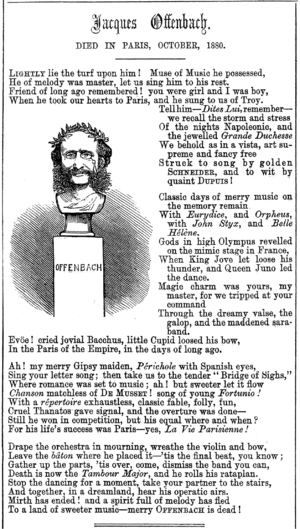
Offenbach had a huge influence on musical theater. Without him, there might not have been the famous Savoy Operas by Gilbert and Sullivan, or popular operettas like Die Fledermaus by Johann Strauss II. Gilbert and Sullivan often used similar ideas and musical styles from Offenbach's works. For example, the police in their opera The Pirates of Penzance are similar to the police in Offenbach's Les brigands.
Offenbach encouraged Johann Strauss to write operettas. Strauss followed Offenbach's style, and Offenbach's works were very popular in Vienna. The composer Franz von Suppé also studied Offenbach's music closely and used it as a model for his own operettas.
Many people believe that Offenbach is one of the most important figures in the history of musical theater. His work helped lead to the modern musical shows we see today.
Even though some critics during his time didn't fully appreciate his music, thinking it would be forgotten, they were wrong. His music is still loved and performed today. Famous composers like Debussy, Bizet, and Mussorgsky admired Offenbach's operettas.
Images for kids
-
Early influences: Luigi Cherubini and Fromental Halévy (top); Louis-Pierre Norblin and Friedrich von Flotow (below)
See also
 In Spanish: Jacques Offenbach para niños
In Spanish: Jacques Offenbach para niños


